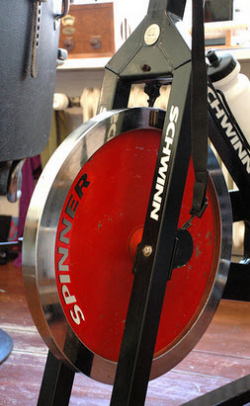 For the cardio component of your workout in your home gym, a stationary bike is one of the best investments you can make. Unlike ellipticals, which focus on toning, stationary bikes can give you a good cardio workout that gets your heart rate up and your lungs working. In order to get the most out of your stationary bike, take time to choose the best one for your budget.
For the cardio component of your workout in your home gym, a stationary bike is one of the best investments you can make. Unlike ellipticals, which focus on toning, stationary bikes can give you a good cardio workout that gets your heart rate up and your lungs working. In order to get the most out of your stationary bike, take time to choose the best one for your budget.
Upright vs. Recumbent Bikes
An upright exercise bike is more like a traditional road bike, where you are positioned directly above the pedals. For obvious reasons, this is the best simulation of riding an actual bike. However, sitting in an upright bike may be uncomfortable on your back for prolonged periods of time. Recumbent bikes attempt to remedy this discomfort by placing you in a more natural, reclined position.
Which is better for you depends on your personal preferences and any recommendations from your physical therapist, if you’re working with one. In terms of which muscles get worked out, recumbent bikes tend to target the glutes better. You may also have less discomfort in your back, neck and wrists with a recumbent bike. But for those who regularly ride road bikes, an upright bike makes the most sense.
Stationary Bike Features
While the bare minimum that you need from a stationary bike is a seat and a pair of pedals, these additional features offer you more value:
- Comfortable seat: This is also a personal preference call. Some prefer firm, narrow seats while others like a cushy, wide seat. Hardcore bikers often complain of “saddle sore” from spending hours on a bike seat, so make sure that your stationary bike’s seat is comfortable to you.
- Adjustable seat and handlebars: All exercise bikes will have some adjustability, but it’s important to ensure that it adjusts to the height/position that’s suitable for everyone who might use it in your home gym. Your legs should be almost fully extended at the bottom of your pedaling motion without stretching, and the handlebars should be easy to reach without causing discomfort.
- Adjustable resistance: A decent exercise bike will let you vary the intensity of your workout, forcing you to pedal harder, if you so choose. This lets you step up or step down your workout according to your needs.
- Feedback: Feedback can help motivate you and let you know how much of a workout you’re getting. At the very least, you should have a timer, a speedometer and an odometer. A heart rate monitor is another useful option. For those who frequently use their exercise bikes, built-in exercise programs are an excellent feature. These will put together workout routines for you in order to push you harder or prevent overexertion. It’s the next best thing to a personal trainer.
How Much to Spend
How much you spend on an exercise bike directly impacts the quality and range of features that you get. You can get a passable stationary bike for $200 to $500, but these bikes will usually be upright without computerized programs. Good brands in this range include Monark, Schwinn, Bodyguard and Tunturi.
For $500 to $1,200, you can get a good Reebok, Schwinn or Keiser upright that’s typical to the kind of bike you’d use in a spinning class.
In the computerized range, expect to pay anywhere between $500 and $3,000 for an upright and anywhere between $500 and $2,000 for a recumbent. Good brand names for computerized bikes are LifeCycle, Precor and Life Fitness.
And remember: as with all exercise equipment, it’s best to try before you buy. Make sure it’s comfortable and ergonomic before you make a purchase.


